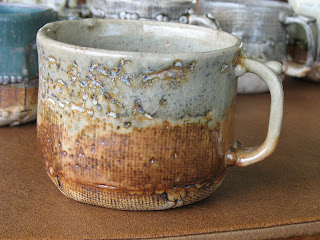Another thing that makes earthenware seem to go faster is that I also make earthenware drum bodies and fire a number of large jars in Raku or Smoke Firing steps. The firing cycle is quicker with the low fire process. I can literally glaze a piece, dry it in the test kiln, run it up to glaze temperatures, and pull it from the kiln the next morning. The higher firing temperatures of Stone ware requires larger kilns, longer and more involved firings.
I am going to show 12 slides; 6 of stoneware and 6 of earthenwares. Most of the earthenware pieces i purchased in markets in Mexico and I constructed the stone ware pieces in the YVCC ceramics studio. Let's dive into the discussion:
The picture above illustrates the main physical difference in Earthenware and Stoneware. Although Stone ware is harder and stronger, if you tried this stunt with a stoneware cup it would shatter. Stone ware works well in a microware and is more durable in a dish washer while Earthenware is softer, but capable of taking a lot of heat shock. Consider that this cup came out of a raku kiln at red hot temperatures and was dumped into leaves, where it smouldered a while and then was further shocked by taking it directly out into the open air.
The cup below is stoneware.
The three cups below are from mexican market. The shiny glazes were traditionally lead based. Between the softer, more fragile nature of these cups and the fact that they don't do well in a dishwasher, they are not as popular as Stone ware cups. The glazes are not as tightly bonded to/with the cup body and tend to chip off over time.
This stoneware cup below is a porcelain body with a Shino under glaze and Celedon over glaze. The cup was stained with an iron oxide slip to highlight the surface texture. This cup holds heat well and should last through years of use without breaking. If you dropped this in a sink or on a concrete floor it would probably shatter. Stoneware glazes are more textured but harder to achieve detail both because of the nature of high fire glazes and because reduction is utilized in firings,
This earthenware plate is from Mexico. It is a red clay body covered with a black slip, highlighted with white slip and colored landscape illustration, then overglazed with a shiny glaze to protect the surface and colors. It is almost more decorative than utilitarian.
Contrast the Mexican plate with this stoneware bowl. The colors have more texture and less detail and the interest is based on the interaction of high fire glazes.
Again (below), more detail, colored surface slips, repetative designs based on color contrast. This bean pot, in it's simple form, could be used on an open fire, though this particular pot is more decorative than utilitarian.
And again, in contrast, see the stoneware cup below. The surface (below) is composed of broad, organic colors and surface texture without detail or designs. We respond to this cup because we know it is very useful and durable.
This Mexican earthenware skillet was designed for use over an open fire. It is suitable for sauteing vegetables, heating tortillas or beans. It is likely that this old skillet has a lead based glaze covering. The lead was easy to work with and helps with controlling color underslips. This piece is larger than it appears here, it is about 12" across the bottom. The handle is short because earthenware is not particularly strong.
This stone ware bowl would never survive on an open flame. It is probably easier to clean with kitchen use and the glaze will not wear or corrode with use.
This tall, handleless earthenware cup is ornate and colorful. However the glaze is already chipping around the lip and cracking is evident in the cup bottom. I suppose earthenware is cheaper to purchase, generally. Stoneware requires a hotter kiln.
To condense the differences into a few statements; Earthenware is softer, easier to decorate with colorful designs, and easier to produce. Stoneware requires more specialized equipment, is more resilent to everyday use, and the surface glazes are more organic.












earthenware fires to a lower temperature (usually cone 06-1), stoneware range is from cone 6-12 (10 in our studio).
ReplyDeleteStoneware is generally a grey clay made with more ball clay, sometimes Gold Art or fire clay. It can have grog or sand.
Earthenware is generally reddish with ball clay, RedArt or fire clay. Often earthenware has sand or grog. Earthenware is sometimes called Terracotta.